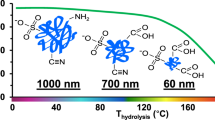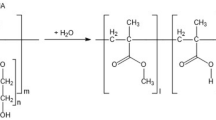Abstract
THE phenomenon of frictional drag reduction in the turbulent flow of Newtonian fluids, by the addition of high molecular weight polymers, has been known for some time. Because of the great potential it offers in various technological applications this phenomenon has generated considerable engineering interest. Unfortunately, when a limited volume of polymer solution is continuously exposed to mechanical shearing action, either by repeated use1 or by passing through long pipelines2, drag reduction rapidly declines, indicating a rapid breakdown of the polymer molecules3. This polymer degradation greatly limits the application of drag reducing polymers. When considering the use of high molecular weight polymers in operating systems their shear stability must be considered as equally important as their effectiveness in drag reduction. Polymer degradation effect is likely to be caused by the scission of molecular entanglements or the breaking of individual molecules induced by the shear stresses associated with very high local shear rates4. But previous studies were made mainly with linear polymers such as polyethylene oxide (PEO) and polyacrylamide (PAM), because a linear structure was believed to be most effective5. We have studied the effect of polymer structure on turbulent drag reduction by synthesising drag-reducing agents of different structures6. Here we present the results of an investigation of the degradation behaviour of a highly branched PAM, and compare the results with those observed with ordinary linear polymers.
This is a preview of subscription content, access via your institution
Access options
Subscribe to this journal
Receive 51 print issues and online access
$199.00 per year
only $3.90 per issue
Buy this article
- Purchase on Springer Link
- Instant access to full article PDF
Prices may be subject to local taxes which are calculated during checkout
Similar content being viewed by others
References
Ellis, A. T., Ting, R. Y., and Nadolink, R. H., J. Hydronautics, 6, 66 (1972).
Paterson, R. W., and Abernathy, F. H., J. Fluid Mech., 43, 689 (1970).
Gadd, G. E., in Encycl. Polym. Sci. Tech., 15, 224 (Interscience, New York, 1971).
Barnard, B. J. S., and Sellin, R. H. J., Nature phys. Sci., 236, 12 (1972).
Hoyt, J. W., and Fabula, A. G., Fifth Nav. Hydrodynamics Symp., ONR, 947 (1964).
Kim, O. K., Little, R. C., and Ting, R. Y., AIChE Symp. Ser., 69, 39 (1973).
Mino, G., Kaiserman, S., and Rasmussen, E., J. Polym. Sci., 38, 393 (1959).
Sholton, W., Makromolec. Chem., 14, 169 (1954).
Little, R. C., and Wiegard, M., J. appl. Polym. Sci., 14, 409 (1970).
Ting, R. Y., and Little, R. C., J. appl. Polym. Sci., 17, 3345 (1973).
Abdel-alim, A. H., and Hamielec, A. E., J. appl. Polym. Sci. (in the press).
Bueche, F., J. appl. Polym. Sci., 4, 101 (1960).
Tennekes, H., and Lumley, J. L., A First Course in Turbulence (MIT Press, Boston, 1972).
White, D. A., Chem. Engng Sci., 25, 1255 (1970).
Ting, R. Y., and Little, R. C., Nature phys. Sci., 241, 42 (1973).
Author information
Authors and Affiliations
Rights and permissions
About this article
Cite this article
KIM, O., LITTLE, R., PATTERSON, R. et al. Polymer structures and turbulent shear stability of drag reducing solutions. Nature 250, 408–410 (1974). https://doi.org/10.1038/250408a0
Received:
Revised:
Issue Date:
DOI: https://doi.org/10.1038/250408a0
This article is cited by
-
Drag reduction methods at solid-liquid interfaces
Friction (2022)
-
Instability in polyethylene oxide solutions in a hydrodynamic field
Journal of Engineering Physics (1988)
-
Instability of aqueous solutions of polyacrylamide in a hydrodynamic field
Journal of Engineering Physics (1985)
Comments
By submitting a comment you agree to abide by our Terms and Community Guidelines. If you find something abusive or that does not comply with our terms or guidelines please flag it as inappropriate.



